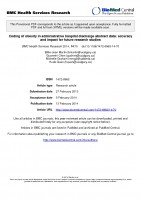Download
| File Size | 168.2 KiB |
|---|---|
| Date | February 21, 2014 |
| Downloads | 5 |
| Author | Billie-Jean Martin, Guanmin Chen, Michelle Graham, Hude Quan |
Abstract
Background: Obesity is a pervasive problem and a popular subject of academic assessment. The ability to take advantage of existing data, such as administrative databases, to study obesity is appealing. The objective of our study was to assess the validity of obesity coding in an administrative database and compare the association between obesity and outcomes in an administrative database versus registry.
Methods: This study was conducted using a coronary catheterization registry and an administrative database (Discharge Abstract Database (DAD)). A Body Mass Index (BMI) ≥30 kg/m2 within the registry defined obesity. In the DAD obesity was defined by diagnosis codes E65 –E68 (ICD-10). The sensitivity, specificity, negative predictive value (NPV) and positive predictive value (PPV) of an obesity diagnosis in the DAD was determined using obesity diagnosis in the registry as the referent. The association between obesity and outcomes was assessed.
Results: The study population of 17380 subjects was largely male (68.8%) with a mean BMI of 27.0kg/m2. Obesity prevalence was lower in the DAD than registry (2.4% vs. 20.3%). A diagnosis of obesity in the DAD had a sensitivity 7.75%, specificity 98.98%, NPV 80.84% and PPV 65.94%. Obesity was associated with decreased risk of death or re-hospitalization, though non-significantly within the DAD. Obesity was significantly associated with an increased risk of cardiac procedure in both databases.
Conclusions: Overall, obesity was poorly coded in the DAD. However, when coded, it was coded accurately. Administrative databases are not an optimal datasource for obesity prevalence and incidence surveillance but could be used to define obese cohorts for follow-up.
Background: Obesity is a pervasive problem and a popular subject of academic assessment. The ability to take advantage of existing data, such as administrative databases, to study obesity is appealing. The objective of our study was to assess the validity of obesity coding in an administrative database and compare the association between obesity and outcomes in an administrative database versus registry.
Methods: This study was conducted using a coronary catheterization registry and an administrative database (Discharge Abstract Database (DAD)). A Body Mass Index (BMI) ≥30 kg/m2 within the registry defined obesity. In the DAD obesity was defined by diagnosis codes E65 –E68 (ICD-10). The sensitivity, specificity, negative predictive value (NPV) and positive predictive value (PPV) of an obesity diagnosis in the DAD was determined using obesity diagnosis in the registry as the referent. The association between obesity and outcomes was assessed.
Results: The study population of 17380 subjects was largely male (68.8%) with a mean BMI of 27.0kg/m2. Obesity prevalence was lower in the DAD than registry (2.4% vs. 20.3%). A diagnosis of obesity in the DAD had a sensitivity 7.75%, specificity 98.98%, NPV 80.84% and PPV 65.94%. Obesity was associated with decreased risk of death or re-hospitalization, though non-significantly within the DAD. Obesity was significantly associated with an increased risk of cardiac procedure in both databases.
Conclusions: Overall, obesity was poorly coded in the DAD. However, when coded, it was coded accurately. Administrative databases are not an optimal datasource for obesity prevalence and incidence surveillance but could be used to define obese cohorts for follow-up.



